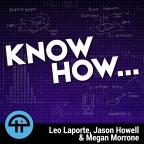
May 21st 2015
Know How... 144
Maker Faire, DMX Lighting, and Questions
Padre gets hit by a packet storm.
Quieter planes, DMX wash lights, custom software for your drone with NVDrone, unbork your network, NFS or SMB, networking CCTV, and more.
Planes are NOISY! (Duh)
- But the science behind that noise is interesting...
- The Noise you hear is a combination of continuous and discontinuous sound sources.
- The continuous noises are most commonly associate with engine and wind noise
- The discontinuous noises are all the other activities that happen on a plane to make noise. (especially conversations)
As a rule of thumb:
- Continuous noise is 60-65db pre-flight, 80-85db takeoff, 75-80db cruise and landing
- Discontinuous noise can go 81-88db (again... because conversations need to take place at a volume louder than continuous noise.)
Here's the thing... one of the major sources of discontinuous noise (conversation) can actually be reduced if you reduce the continuous noise.)
But... how do you reduce cont noise?
- That noise comes from the engines and the air rushing past the cabin.
- You can't stop the engines, and you'll always have air turbulence across the fuselage.
- And you can't insulate the cabin because that adds a TON (literally) of weight that would make the economics of flying impossible.
Well... researchers from North Carolina State University and MIT have created a way to insulate planes that doesn't add that much weight.
- They've designed a 0.25mm sheet of latex that can cover the existing honeycomb structure that forms the skin of modern aircraft.
- The sheet is stretched over that honeycomb structure
- That turns the little each of the little honeycomb units into a drum.
More importantly, it's a drum that bounces low-frequency noises.
- Low Frequency noises are also known as "engine noise"
The researchers found that the simple membrane, deployed this way, can block 100 to 1,000 times more sound energy than a honeycomb lattice without the latex.
- This translates into a drop of as much as 30db of continuous noise in the cabin
- So if you can get the cruising noise down to 45db, you can get the discontinuous noise down to 50db... imagine that!
AND -- it only adds 6% weight to the honeycomb structure, which is of itself, only a small percentage of the total weight of the aircraft.
Wash Lights:
- Wash lights provide a LOT of light, but the can't be focused.
- As opposed to Par cans, fresnels, etc... they're not used in light-shaping, but rather just to give a "wash" of light to add color.
Let's talk about Wash lights!
DMX512
- This is the standard for digital communication with stage devices
- It replaced several proprietary standards that had been used for controlling dimmer packs.
- DMX is an upgrade because is doesn't just control lighting, but can ber used for fog machines, lasers, and billboards.
A few important notes:
- DMX512 is unidirectional. There is no "talkback" from the target devices.
- DMX512 has no error checking.
- DMX512 is prone to interference (EM, static, bad cables)
But, on the plus side:
- DMX is simple. Plug and play.
- DMX can be saidy chained. (in-out) up to 1,200 meters and 32 load units per bus.
- DMX can be split and repeated for larger applications
- You can control multiple DMX buses from a single controller
DMX is supposed to use XLR-5, but many units have changed to XLR-3.
Connect with us!
- Don't forget to check out our large library of projects at https://twit.tv/shows/know-how.
- Tweet at us at @PadreSJ, @Cranky_Hippo, and @Anelf3.
Thanks to CacheFly for the bandwidth for this show.




